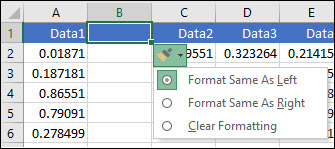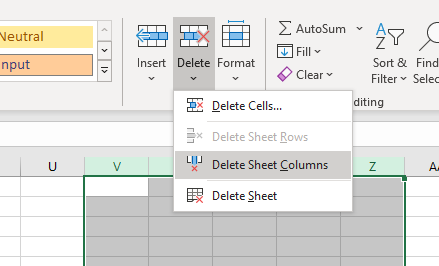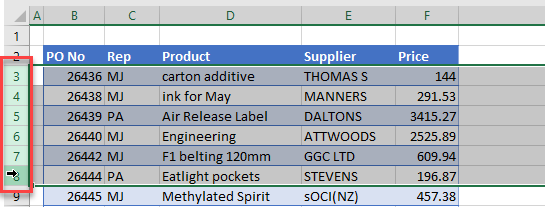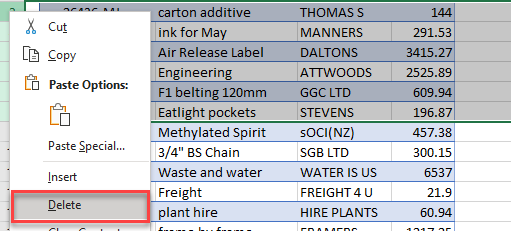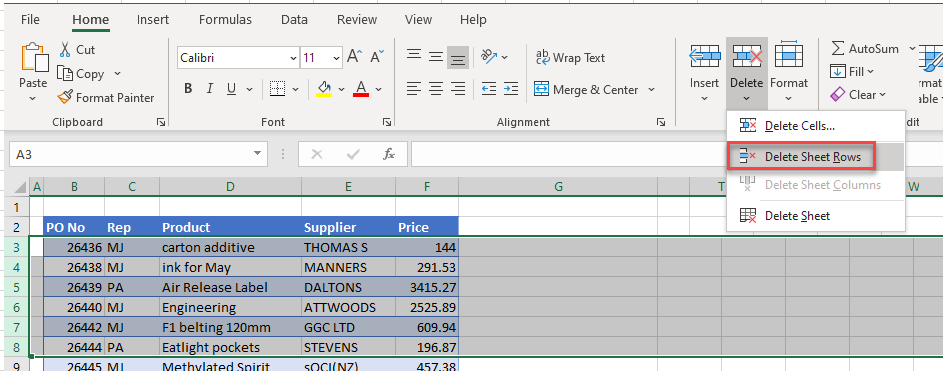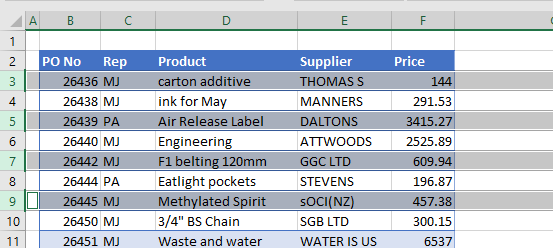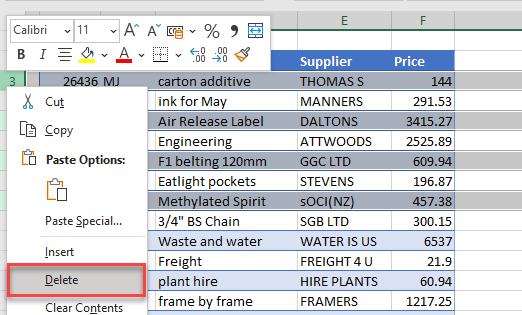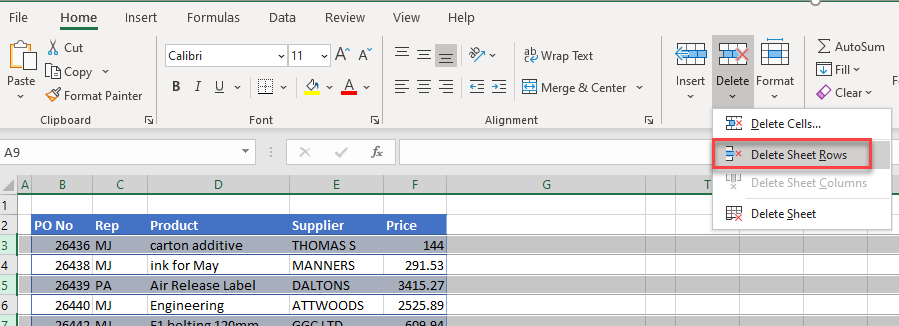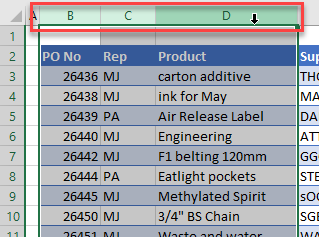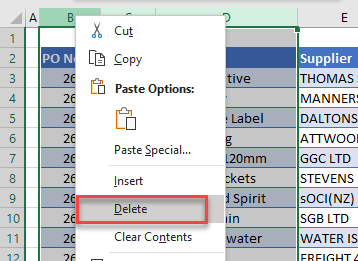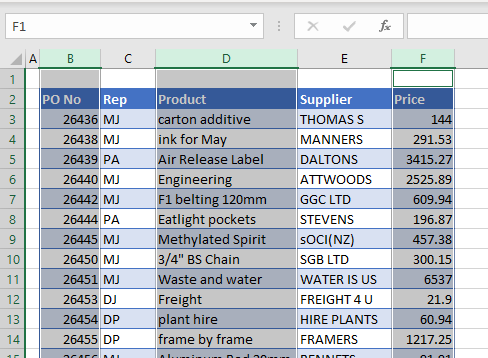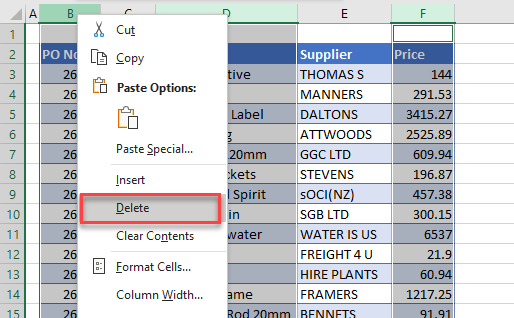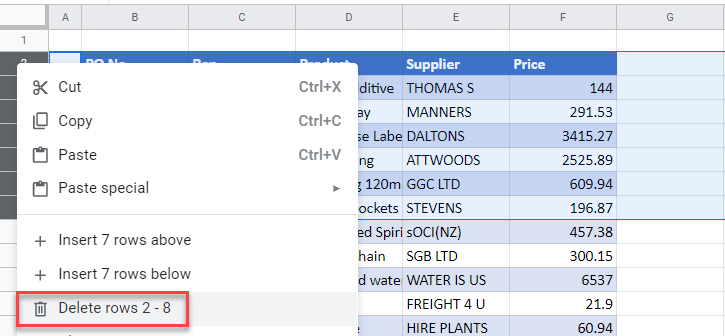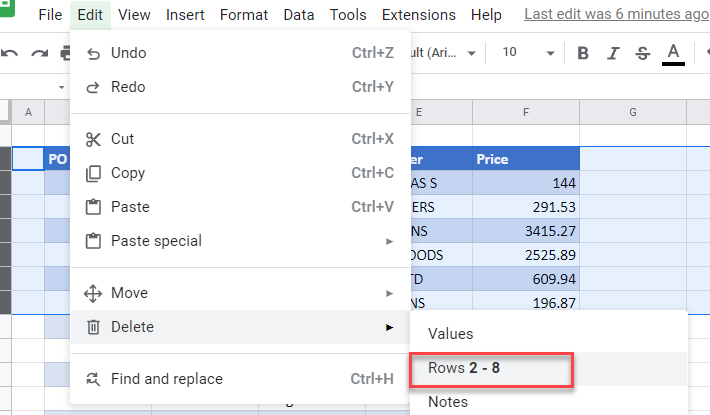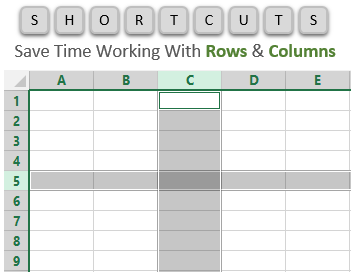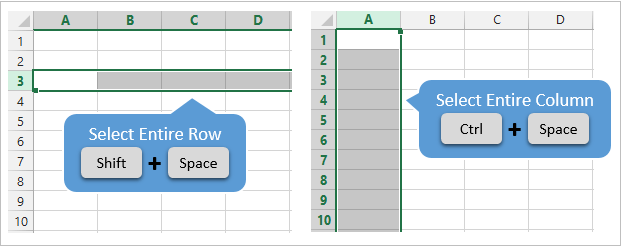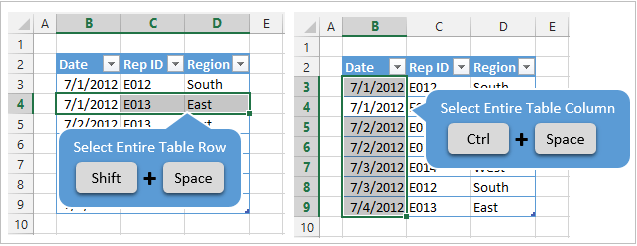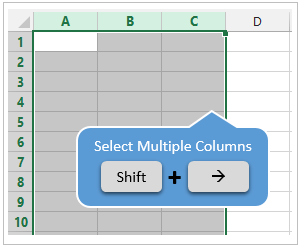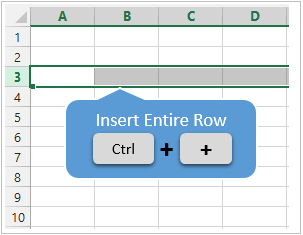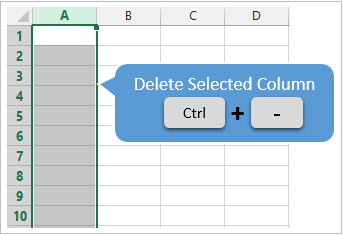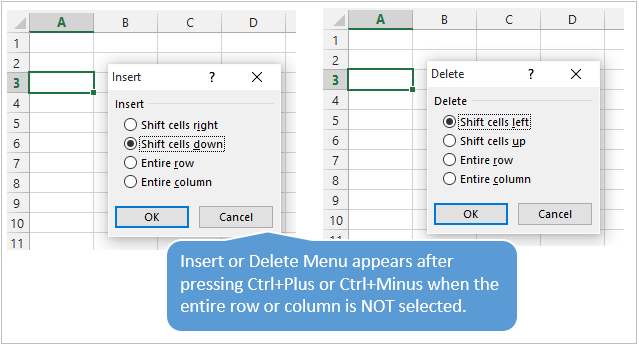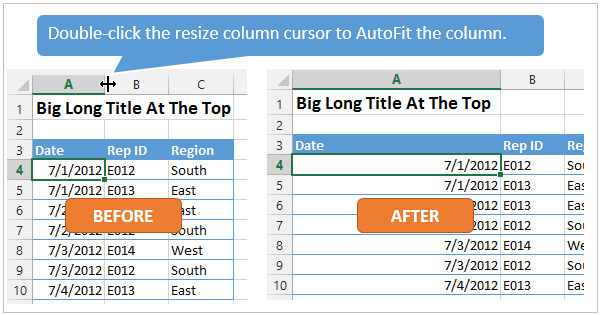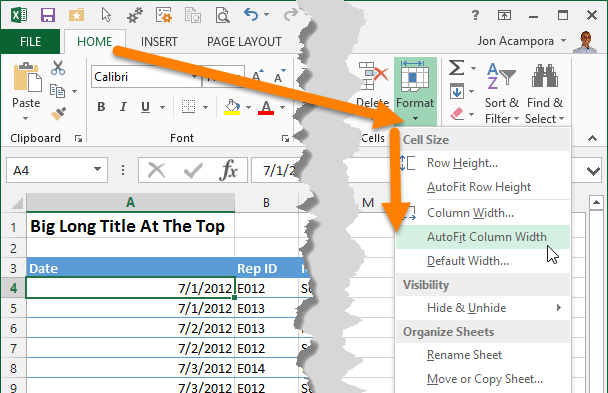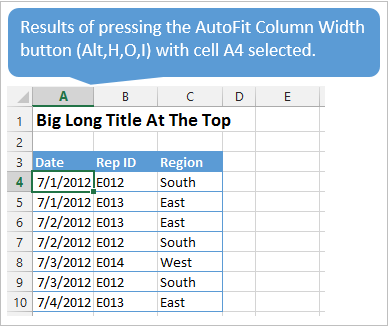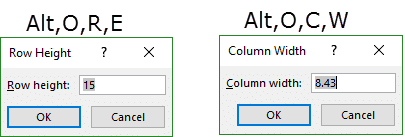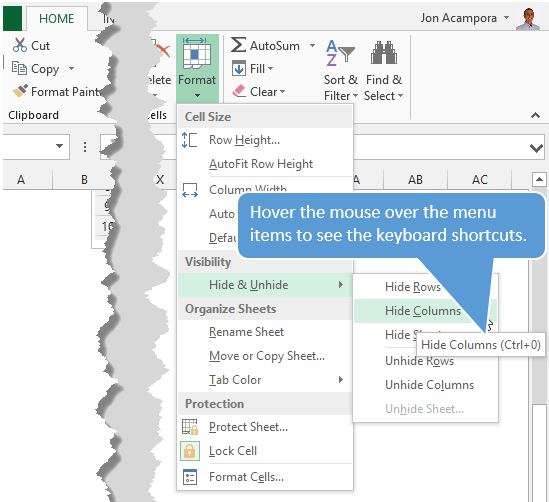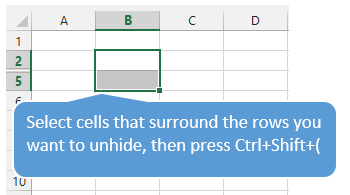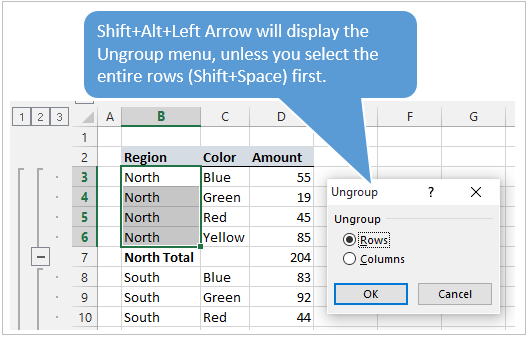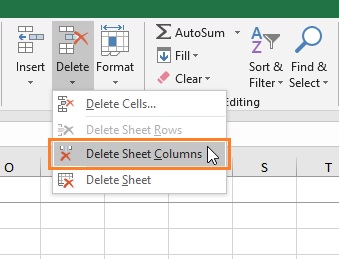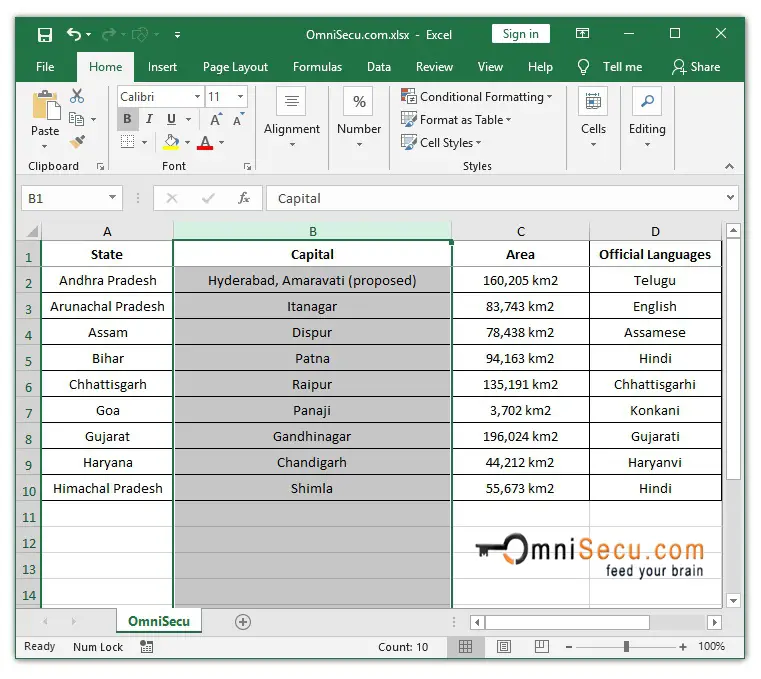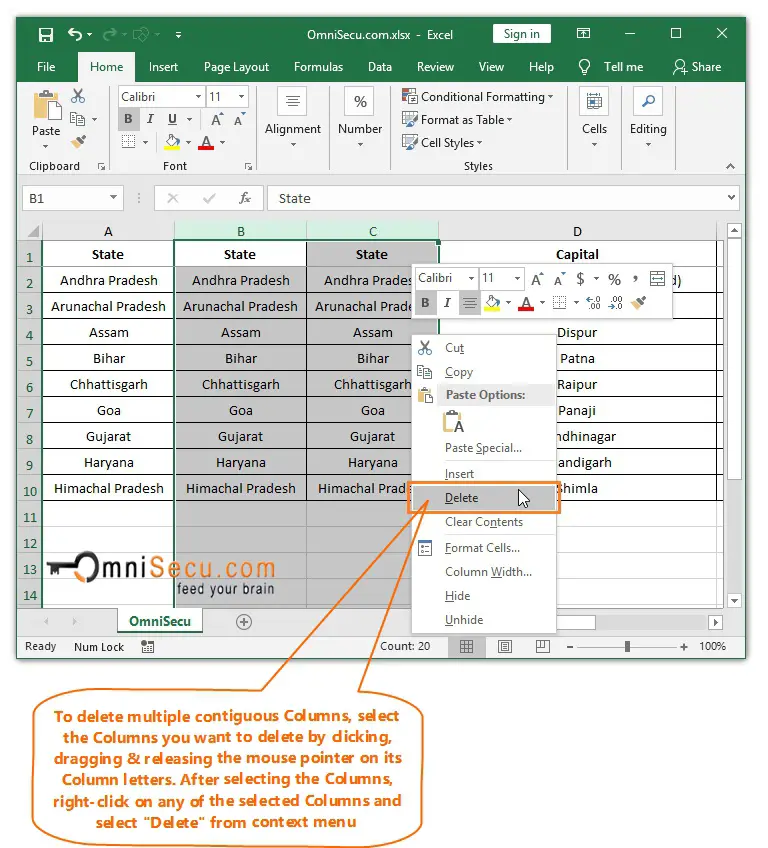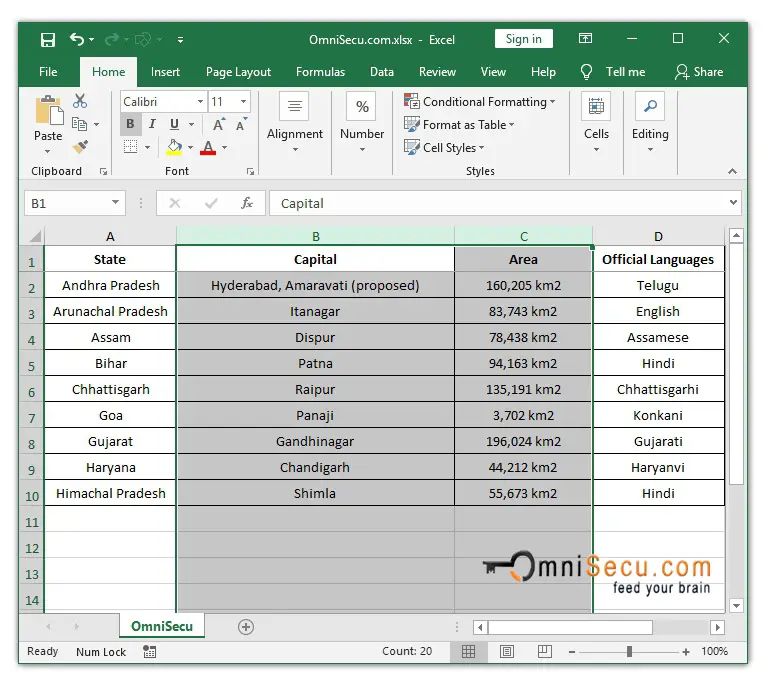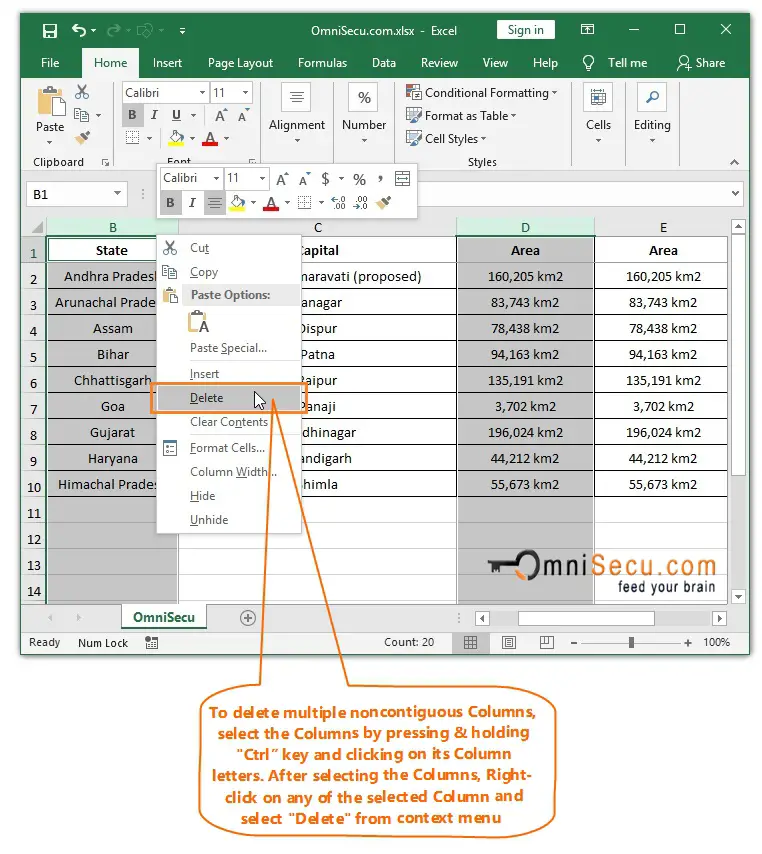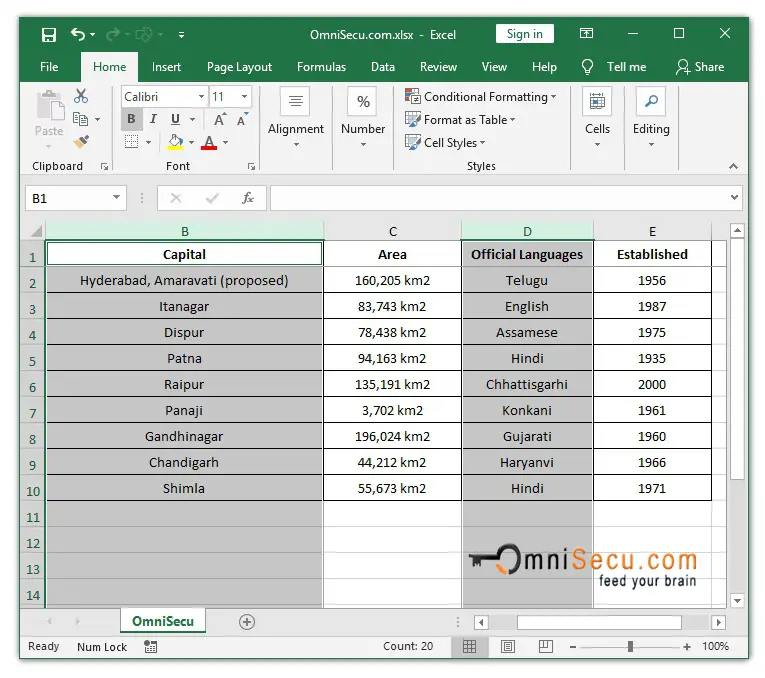Insert or delete rows and columns
Insert and delete rows and columns to organize your worksheet better.
Note: Microsoft Excel has the following column and row limits: 16,384 columns wide by 1,048,576 rows tall.
Insert or delete a column
-
Select any cell within the column, then go to Home > Insert > Insert Sheet Columns or Delete Sheet Columns.
-
Alternatively, right-click the top of the column, and then select Insert or Delete.
Insert or delete a row
-
Select any cell within the row, then go to Home > Insert > Insert Sheet Rows or Delete Sheet Rows.
-
Alternatively, right-click the row number, and then select Insert or Delete.
Formatting options
When you select a row or column that has formatting applied, that formatting will be transferred to a new row or column that you insert. If you don’t want the formatting to be applied, you can select the Insert Options button after you insert, and choose from one of the options as follows:
If the Insert Options button isn’t visible, then go to File > Options > Advanced > in the Cut, copy and paste group, check the Show Insert Options buttons option.
Insert rows
To insert a single row: Right-click the whole row above which you want to insert the new row, and then select Insert Rows.
To insert multiple rows: Select the same number of rows above which you want to add new ones. Right-click the selection, and then select Insert Rows.
Insert columns
To insert a single column: Right-click the whole column to the right of where you want to add the new column, and then select Insert Columns.
To insert multiple columns: Select the same number of columns to the right of where you want to add new ones. Right-click the selection, and then select Insert Columns.
Delete cells, rows, or columns
If you don’t need any of the existing cells, rows or columns, here’s how to delete them:
-
Select the cells, rows, or columns that you want to delete.
-
Right-click, and then select the appropriate delete option, for example, Delete Cells & Shift Up, Delete Cells & Shift Left, Delete Rows, or Delete Columns.
When you delete rows or columns, other rows or columns automatically shift up or to the left.
Tip: If you change your mind right after you deleted a cell, row, or column, just press Ctrl+Z to restore it.
Insert cells
To insert a single cell:
-
Right-click the cell above which you want to insert a new cell.
-
Select Insert, and then select Cells & Shift Down.
To insert multiple cells:
-
Select the same number of cells above which you want to add the new ones.
-
Right-click the selection, and then select Insert > Cells & Shift Down.
Need more help?
You can always ask an expert in the Excel Tech Community or get support in the Answers community.
See Also
Basic tasks in Excel
Overview of formulas in Excel
Need more help?
Want more options?
Explore subscription benefits, browse training courses, learn how to secure your device, and more.
Communities help you ask and answer questions, give feedback, and hear from experts with rich knowledge.
Answer: Select a cell in the column that you wish to delete. In this example, we’ve selected cell B3 because we want to delete colulmn B. Right-click and select “Delete” from the popup menu. When the Delete window appears, select the “Entire column” option and click on the OK button.
Contents
- 1 How do you delete a whole column?
- 2 What is the shortcut to delete a column in Excel?
- 3 How do you select an entire column in Excel?
- 4 How do you total a column in Excel?
- 5 Which key is used to delete a column?
- 6 What is the shortcut key to hide entire column?
- 7 How do I delete empty rows in Excel?
- 8 How do you select entire column in Excel without dragging?
- 9 How do you select an entire column in Excel without blank?
- 10 How do I select an entire column in Excel without the header?
- 11 How do you total a column in sheets?
- 12 How do I get a total row in Excel?
- 13 How do I Sum a column of text in Excel?
- 14 What is the shortcut key to delete?
- 15 What is the shortcut to delete multiple columns in Excel?
- 16 How do you delete and shift cells up in Excel shortcut?
- 17 What is Ctrl 0 Excel?
- 18 How do I hide columns in Excel without right clicking?
- 19 How do I delete unused columns and rows in Excel?
- 20 How do you remove infinite columns in Excel?
How do you delete a whole column?
To do this, select the row or column and then press the Delete key.
- Right-click in a table cell, row, or column you want to delete.
- On the menu, click Delete Cells.
- To delete one cell, choose Shift cells left or Shift cells up. To delete the row, click Delete entire row. To delete the column, click Delete entire column.
What is the shortcut to delete a column in Excel?
To delete a row or column using keyboard shortcuts, move your cursor to the row or column you want to delete. Click ‘Shift’ plus the ‘Spacebar’ to select the row, or ‘Ctrl’ plus the ‘Spacebar’ to select the column, then click ‘Ctrl’ plus the ‘Minus’ sign found in your number pad. Voila!
How do you select an entire column in Excel?
Select one or more rows and columns
Select the letter at the top to select the entire column. Or click on any cell in the column and then press Ctrl + Space.
How do you total a column in Excel?
If you need to sum a column or row of numbers, let Excel do the math for you. Select a cell next to the numbers you want to sum, click AutoSum on the Home tab, press Enter, and you’re done. When you click AutoSum, Excel automatically enters a formula (that uses the SUM function) to sum the numbers. Here’s an example.
Which key is used to delete a column?
Press and hold the Ctrl key. Press and release the ” – ” key without releasing the Ctrl key. The three selected columns are deleted.
What is the shortcut key to hide entire column?
Ctrl+0 (zero) to Hide Columns.
How do I delete empty rows in Excel?
Easy Ways to Remove Blank or Empty Rows in Excel
- Select the row. Click its heading or select a cell in the row and press Shift + spacebar.
- Right-click the selected row heading. A drop-down menu appears.
- Select Delete.
How do you select entire column in Excel without dragging?
To select a range of cells without dragging the mouse:
- Click in the cell which is to be one corner of the range of cells.
- Move the mouse to the opposite corner of the range of cells.
- Hold down the Shift key and click.
How do you select an entire column in Excel without blank?
Select and Copy only the non-blank range using Go To Special
- First, select the entire range.
- Press CTRL+G shortcut to open the Go To Dialog box.
- At the bottom of the dialog, you can see the “Special” button.
- Now from the available options, select the Constants and Hit Ok.
- Now use CTRL+C to copy the selected range.
How do I select an entire column in Excel without the header?
If you want to select Entire Column except Header row and also excluding all blank cells in your worksheet, you can use a shortcut keys to achieve the result. Just select the first cell except header cell, and press Shift + Ctrl + Down keys.
How do you total a column in sheets?
What to Know
- Easiest option: Click the cell, select SUM in the Functions menu, and select the cells you want to add.
- Or click the cell, enter =SUM( and select the cells. Close with ). Press Enter.
- You can also use the Function button to create a sum.
How do I get a total row in Excel?
You can quickly total data in an Excel table by enabling the Toggle Total Row option.
- Click anywhere inside the table.
- Click the Table Design tab > Style Options > Total Row. The Total row is inserted at the bottom of your table.
How do I Sum a column of text in Excel?
In the Choose a formula list box, click to select Sum based on the same text option; Then, in the Arguments input section, select the range of cells containing the text and numbers that you want to sum in the Range textbox, and then, select the text cell you want to sum values based on in the Text textbox.
What is the shortcut key to delete?
| To delete | Press |
|---|---|
| Next character | Delete |
| Next word | Ctrl+Delete or Ctrl+Backspace |
| Previous character | Backspace |
What is the shortcut to delete multiple columns in Excel?
To delete row or column by shortcut keys
Select the entire row/column you want to delete, if you want to delete several rows/columns at once time, press Ctrl key to select them, then press Ctrl + – keys delete.
How do you delete and shift cells up in Excel shortcut?
Cell deletion options include:
- Ctrl + “-“ + L: Shifts cells left.
- Ctrl + “-“ + U: Shift cells up.
What is Ctrl 0 Excel?
CTRL+0 hides the selected columns in Excel.
How do I hide columns in Excel without right clicking?
Hide Columns in Excel Using a Keyboard Shortcut
Press and hold down the Ctrl key on the keyboard. Press and release the 0 key without releasing the Ctrl key. The column containing the active cell should be hidden from view.
How do I delete unused columns and rows in Excel?
To delete unwanted rows and columns in your spreadsheet, just simply highlight the row or column by clicking the marker on top of the column or to the left of the row, just right-click it and then click delete. Hope this helps you.
How do you remove infinite columns in Excel?
Delete infinite rows from Excel
- Select the entire range and apply AutoFilter.
- Click an AutoFilter DropDown.
- Uncheck all and then check the blanks option only (So only blanks visible)
- If it is entire rows of blanks that you want to delete and some columns have data in them then repeat 2 and 3 for all columns of data.
See all How-To Articles
This tutorial demonstrates how to delete multiple rows or columns in Excel and Google Sheets.
By selecting multiple rows or columns in Excel, you can quickly delete any number of rows or columns using the right mouse button or the Excel Ribbon. This can also be done with VBA.
Delete Adjacent Rows
To delete multiple rows in your worksheet, select the rows you wish to delete by clicking on the row header and dragging down to the header of the last row you wish to delete.
Right-click on the row header and select Delete.
OR
In the Ribbon, select Home > Cells > Delete > Delete Sheet Rows.
Delete Non-Adjacent Rows
To delete multiple non-adjacent rows, select the first row you wish to delete by clicking on the row header, and then, holding down the CTRL key, click on each additional row you wish to delete.
Right-click on the row header and select Delete.
OR
In the Ribbon, select Home > Cells > Delete > Delete Sheet Rows.
Delete Adjacent Columns
To delete multiple adjacent columns, select the columns you wish to delete by clicking on the column header and dragging across to the header of the last column you wish to delete.
Right-click on the column header and select Delete.
OR
In the Ribbon, select Home > Cells > Delete > Delete Sheet Columns.
Delete Non-Adjacent Columns
To delete multiple non-adjacent columns, select the columns you wish to delete by clicking on the first column header and then, holding down the CTRL key, click on each additional column header of the columns you wish to delete.
Right-click on the column header and select Delete.
OR
In the Ribbon, select Home > Cells > Delete > Delete Sheet Columns.
Delete Multiple Rows and Columns in Google Sheets
Deleting multiple rows and columns in Google Sheets works much the same as it does in Excel.
You can select adjacent rows or columns by clicking on the row or column header and dragging down or across to the row or column header of the last row or column you wish to delete.
You can select non-adjacent rows or columns by clicking on the first row or column header, and then, holding down the CTRL key, click on any further row or column headers required.
As with Excel, click on the row/column header with the right mouse button and select the Delete option from the quick menu (e.g., Delete rows 2 – 8).
OR
In the Menu, select Edit > Delete, and then select the options (e.g., Rows 2 – 8) as shown below.
Bottom line: Learn some of my favorite keyboard shortcuts when working with rows and columns in Excel.
Skill level: Easy
Whether you are creating a simple list of names or building a complex financial model, you probably make a lot of changes to the rows and columns in the spreadsheet. Tasks like adding/deleting rows, adjusting column widths, and creating outline groups are very common when working with the grid.
This post contains some of my favorite shortcuts that will save you time every day.
I’ve also listed the equivalent shortcuts for the Mac version of Excel where available.
#1 – Select Entire Row or Column
Shift+Space is the keyboard shortcut to select an entire row.
Ctrl+Space is the keyboard shortcut to select an entire column.
Mac Shortcuts: Same as above
The keyboard shortcuts by themselves don’t do much. However, they are the starting point for performing a lot of other actions where you first need to select the entire row or column. This includes tasks like deleting rows, grouping columns, etc.
These shortcuts also work for selecting the entire row or column inside an Excel Table.
When you press the Shift+Space shortcut the first time it will select the entire row within the Table. Press Shift+Space a second time and it will select the entire row in the worksheet.
The same works for columns. Ctrl+Space will select the column of data in the Table. Pressing the keyboard shortcut a second time will include the column header of the Table in the selection. Pressing Ctrl+Space a third time will select the entire column in the worksheet.
You can select multiple rows or columns by holding Shift and pressing the Arrow Keys multiple times.
#2 – Insert or Delete Rows or Columns
There are a few ways to quickly delete rows and columns in Excel.
If you have the rows or columns selected, then the following keyboard shortcuts will quickly add or delete all selected rows or columns.
Ctrl++ (plus character) is the keyboard shortcut to insert rows or columns. If you are using a laptop keyboard you can press Ctrl+Shift+= (equal sign).
Mac Shortcut: Cmd++ or Cmd+Shift+
Ctrl+- (minus character) is the keyboard shortcut to delete rows or columns.
Mac Shortcut: Cmd+-
So for the above shortcuts to work you will first need to select the entire row or column, which can be done with the Shift+Space or Ctrl+Space shortcuts explained in #1.
If you do not have the entire row or column selected then you will be presented with the Insert or Delete Menus after pressing Ctrl++ or Ctrl+-.
You can then press the up or down arrow keys to make your selection from the menu and hit Enter. For me it is easier to first select the entire row or column, then press Ctrl++ or Ctrl+-.
So, the entire keyboard shortcut to delete a column would be Ctrl+Space, Ctrl+-. You could also use the keyboard shortcut Alt+H+D+C to delete columns and Alt+H+D+R to delete rows. There are lots of ways to do a simple task… 🙂
#3 – AutoFit Column Width
There are also a lot of different ways to AutoFit column widths. AutoFit means that the width of the column will be adjusted to fit the contents of the cell.
You can use the mouse and double-click when you hover the cursor between columns when you see the resize column cursor.
The problem with this is that you might just want to resize the column for the date in cell A4, instead of the big long title in cell A1. To accomplish this you can use the AutoFit Column Width button. It is located on the Home tab of the Ribbon in the Format menu.
The AutoFit Column Width button bases the width of the column on the cells you have selected. In the image above I have cell A4 selected. So the column width will be adjusted to fit the contents of A4, as shown in the results below.
Alt,H,O,I is the keyboard shortcut for the AutoFit Column Width button. This is one I use a lot to get my reports looking shiny. 🙂
Alt,H,O,A is the keyboard shortcut to AutoFit Row Height. It doesn’t work exactly the same as column width, and will only adjust the row height to the tallest cell in the entire row.
Mac Shortcuts: None that I know of. The Mac version does not use the Alt key sequence which I believe is a limitation of the Mac OS.
#3.5 – Manually Adjust Row or Column Width
The column width or row height windows can be opened with keyboard shortcuts as well.
Alt,O,R,E is the keyboard shortcut to open the Row Height window.
Alt,O,C,W is the keyboard shortcut to open the Column Width window.
The row height or column width will be applied to the rows or columns of all the cells that are currently selected.
These are old shortcuts from Excel 2003, but they still work in the modern versions of Excel.
Mac Shortcuts: None that I know of. The Mac version does not use the Alt key sequence which I believe is a limitation of the Mac OS.
#4 – Hide or Unhide Rows or Columns
There are several dedicated keyboard shortcuts to hide and unhide rows and columns.
- Ctrl+9 to Hide Rows
- Ctrl+0 (zero) to Hide Columns
- Ctrl+Shift+( to Unhide Rows
- Ctrl+Shift+) to Unhide Columns – If this doesn’t work for you try Alt,O,C,U (old Excel 2003 shortcut that still works). You can also modify a Windows setting to prevent the conflict with this shortcut. See the comment from Pablo Baez on Oct 5, 2015 below for further instructions. Thanks Pablo! 🙂
Mac Shortcuts: Same as above
The buttons are also located on the Format menu on the Home tab of the Ribbon. You can hover over any of the items in the menu and the keyboard shortcut will display in the screentip (see screenshot below).
The trick with getting these shortcuts to work is to have the proper cells selected first.
To hide rows or columns you just need to select cells in the rows or columns you want to hide, then press the Ctrl+9 or Ctrl+Shift+( shortcut.
To unhide rows or columns you first need to select the cells that surround the rows or columns you want to unhide. In the screenshot below I want to unhide rows 3 & 4. I first select cell B2:B5, cells that surround or cover the hidden rows, then press Ctrl+Shift+( to unhide the rows.
The same technique works to unhide columns.
#5 – Group or Ungroup Rows or Columns
Row and Column groupings are a great way to quickly hide and unhide columns and rows.
Shift+Alt+Right Arrow is the shortcut to group rows or columns.
Mac Shortcut: Cmd+Shift+K
Shift+Alt+Left Arrow is the shortcut to ungroup.
Mac Shortcut: Cmd+Shift+J
Again, the trick here is to select the entire rows or columns you want to group/ungroup first. Otherwise you will be presented with the Group or Ungroup menu.
Alt,A,U,C is the keyboard shortcut to remove all the row and columns groups on the sheet. This is the same as pressing the Clear Outline button on the Ungroup menu of the Data tab on the Ribbon.
*Bonus funny: At some point when using the group/ungroup shortcuts, you will accidentally press Ctrl+Alt+Right Arrow. This is a Windows shortcut that orientates the entire screen to the right. I call it “neck ache view”. To get it back to normal press Ctrl+Alt+Up Arrow.
If your co-worker or boss accidentally leaves their computer unlocked and you want to play a joke on them, press Ctrl+Alt+Down Arrow. This will turn their screen upside down. Don’t forget to record a video of their WTF reaction… 🙂
What Are Your Favorites?
There are a ton of keyboard shortcuts for working with rows and columns. The above are some of my favorites that I use everyday. What are some of your favorites? Please leave a comment below. Thanks! 🙂
Sometimes Excel worksheet data may contain Columns which you want to delete. The Columns which you want to delete may be wrong, duplicate or irrelevant.
In an Excel Worksheet, there are 16384 total columns available. When you delete a new Column, the total available number of Columns in Excel worksheet do not change. New blank Columns (equivalent to the deleted number of Columns) will be inserted at extreme right-side of the worksheet to maintain the total number of Columns the same.
To delete Columns from Excel worksheet, follow any of below methods.
Method 1 — How to delete a single Column from Excel worksheet
Step 1 — Select the Column which you want to delete by clicking on its Column letter. After selecting the Column letter, right-click anywhere on the Column and select «Delete» from the context menu. In this example I had selected Column B, by clicking on its Column letter.
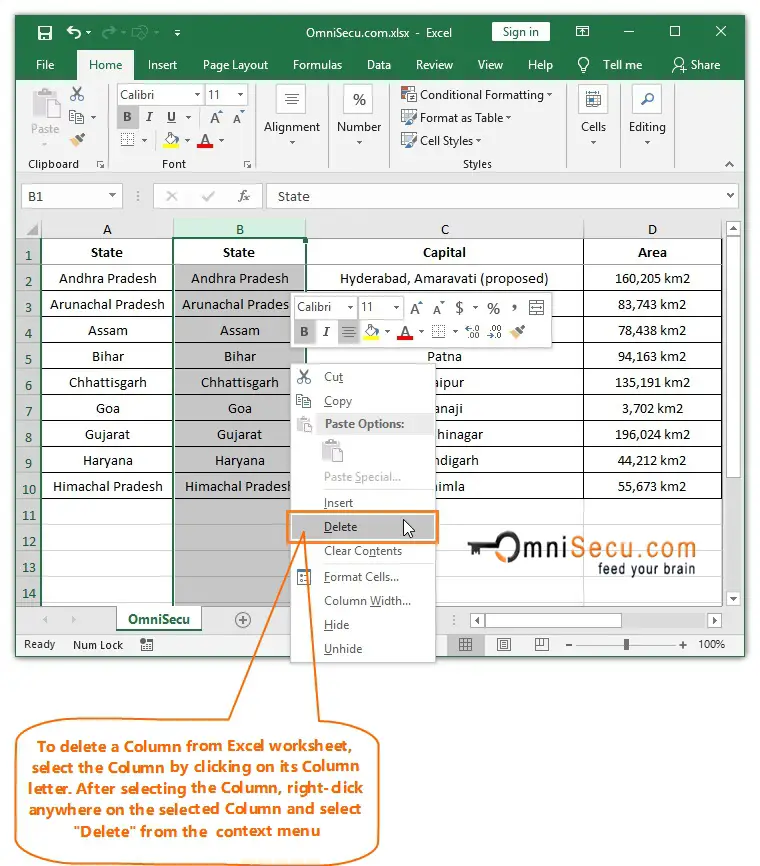
Another way to achieve the same result is by running «Delete Sheet Columns» command from Excel Ribbon > «Cells» Group > «Delete» menu button as shown below.
Step 2 — Entire Column B is deleted from Excel worksheet. The Column right-side the deleted Column is moved to left by one Column to occupy the position of deleted Column. All Column at right-side of the deleted Column are moved to left by one Column, as shown in below image.
Below Animation shows how to delete single Column from Excel worksheet.
If you want to delete large number of Columns from an Excel worksheet, it is not an efficient method to delete single Column one by one. If you want to delete large number of Columns, follow any of below methods.
Method 2 — How to delete multiple contiguous Columns from Excel worksheet
To delete multiple contiguous Columns from Excel worksheet, follow these steps.
Step 1 — Select the Columns you want to delete from Excel worksheet by clicking, dragging and releasing mouse pointer on its Column letters. In this example, I want to delete Column B and Column C from Excel worksheet. Hence, I had selected Column B and Column C.
After selecting the Columns, right-click on any of the selected Columns and select «Delete» from context menu, as shown in below image.
Step 2 — Two selected contiguous Columns are deleted from Excel worksheet. Columns at the right-side the deleted Columns are moved to left to occupy the position of two deleted Columns. All Columns at right-side of the deleted Columns are moved to left-side by two Columns, as shown in below image.
Below Animation shows how to delete multiple contiguous Columns from Excel worksheet.
Method 3 — How to delete multiple noncontiguous Columns from Excel worksheet
To delete multiple noncontiguous Columns from Excel worksheet, follow these steps.
Step 1 — Select the noncontiguous Columns you want to delete by pressing & holding «Ctrl» key and then clicking on its Column Letters. In this example, I want to delete two noncontiguous Columns, Column B and Column D, from Excel worksheet. Hence, I had selected Column B and Column D.
After selecting multiple noncontiguous Columns you want to delete, right-click on any of the selected Rows and select «Delete» from context menu as shown in below image.
Step 2 — Column B and Column D are deleted from Excel worksheet. The Columns at right-side of Column B and Column D are moved to left to replace Column B and Column D, as shown in below image.
Below Animation shows how to delete multiple contiguous Columns from Excel worksheet.


